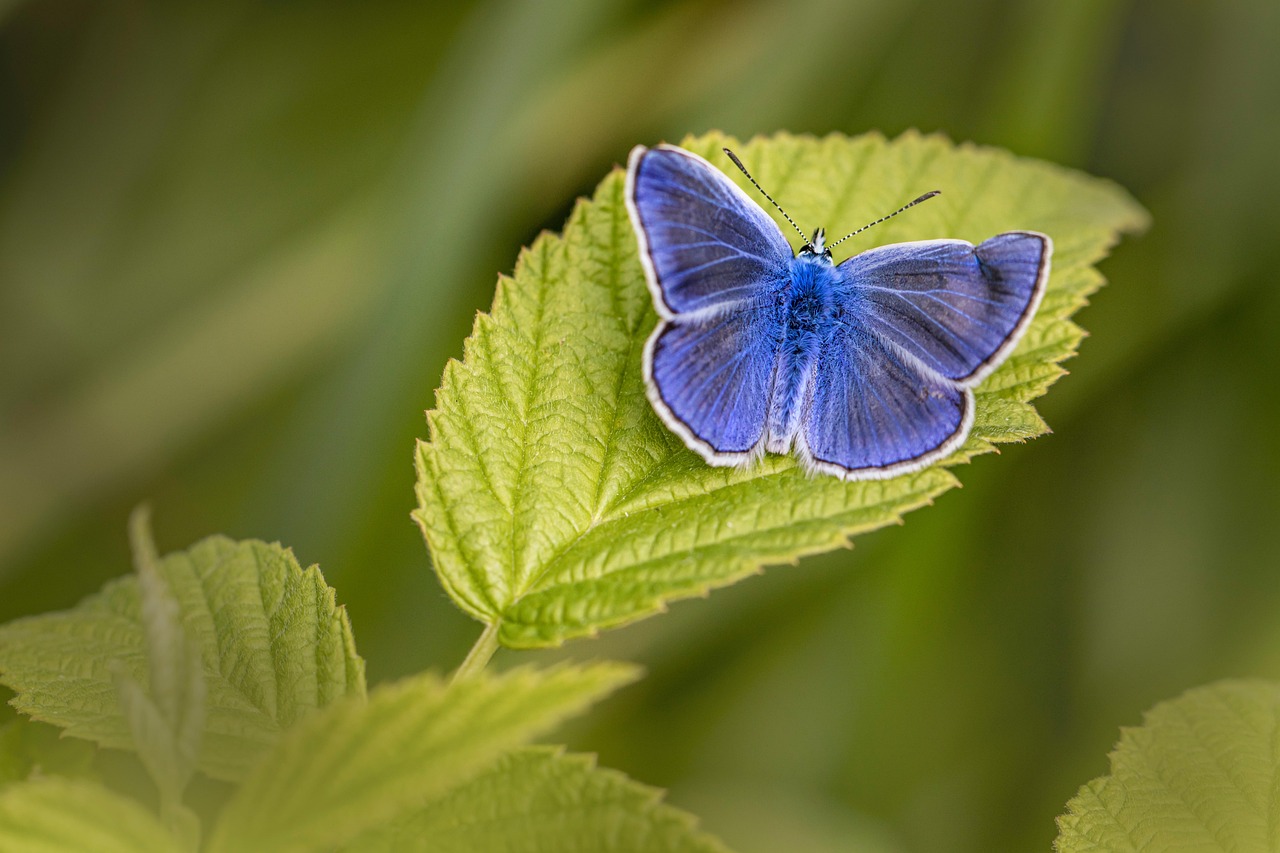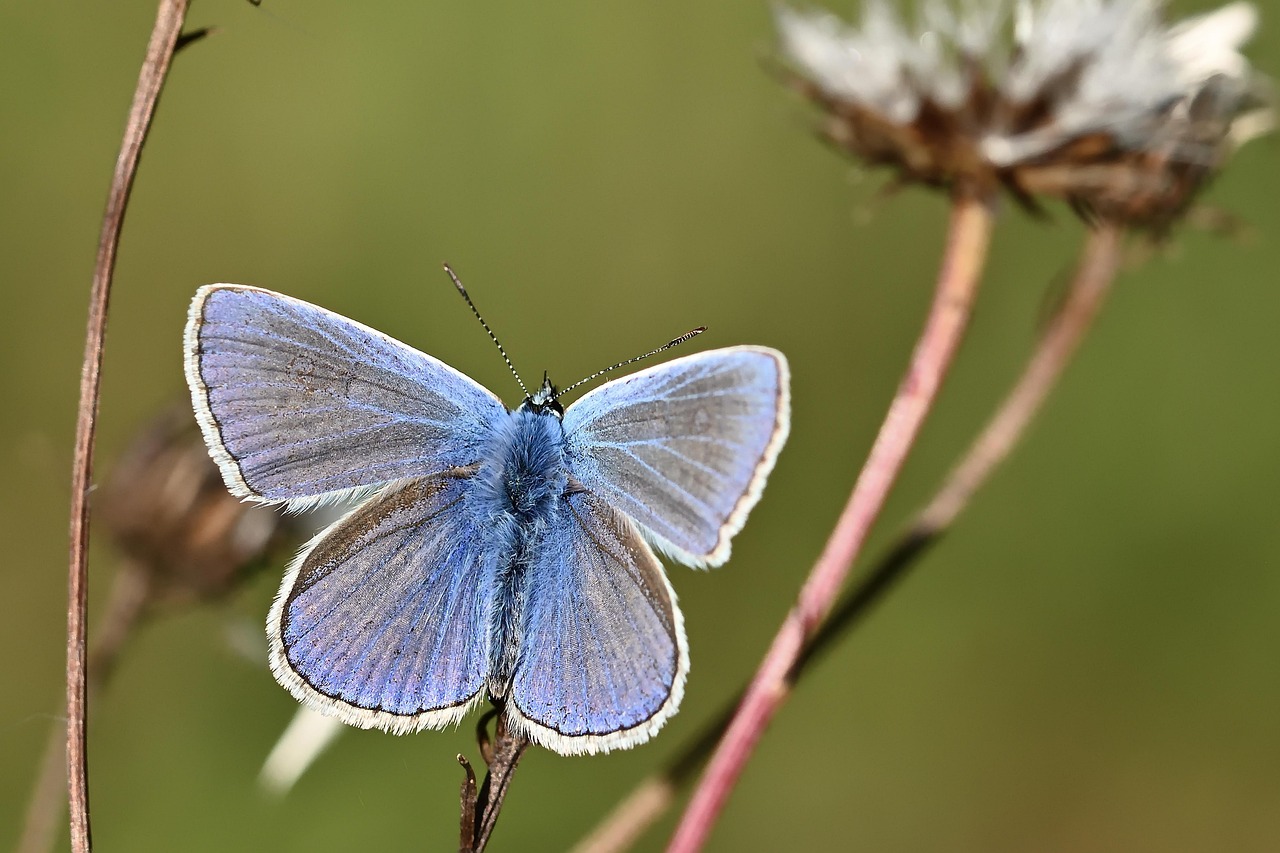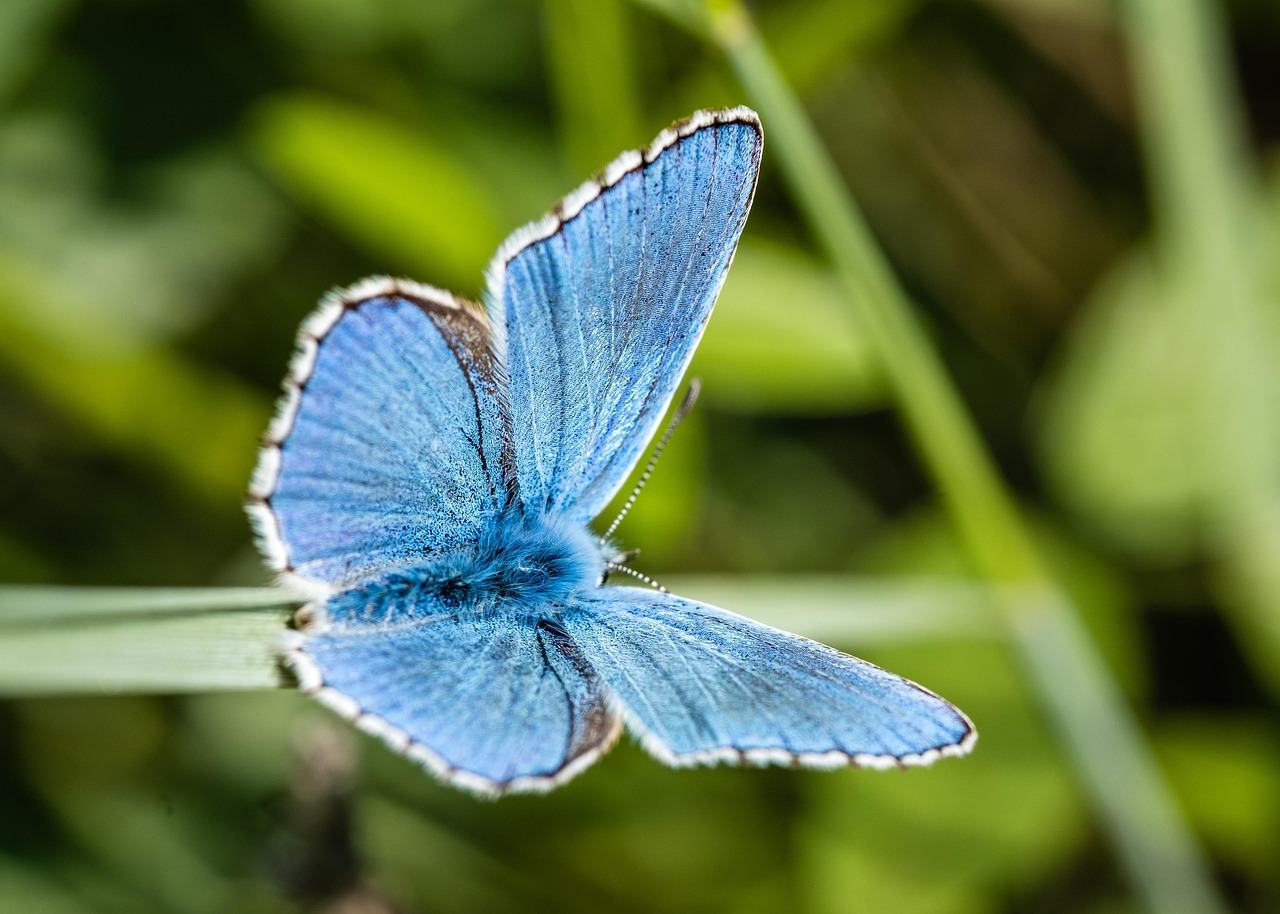The Karner Blue Butterfly primarily relies on specific food sources throughout its life cycle. The caterpillars predominantly feed on the leaves of wild lupine plants, while adult butterflies primarily consume nectar from a variety of flowering plants, including milkweeds and asters.
Understanding the Karner Blue Butterfly

The Karner Blue Butterfly (Plebejus melissa samuelis) is a small, vibrant butterfly known for its striking blue wings. This species is a subspecies of the Melissa Blue Butterfly and is primarily found in sandy areas of the northeastern United States. Its life cycle includes distinct stages: egg, larva (caterpillar), pupa, and adult. Each stage relies on different food sources that are crucial for their survival.
The caterpillars of the Karner Blue Butterfly have a specialized diet that focuses on wild lupine (Lupinus perennis). This plant is essential for the caterpillar’s growth and development. Adult butterflies, on the other hand, have a more diverse diet that includes various nectar-producing flowers. Understanding these food sources is vital for conservation efforts aimed at protecting this endangered species.
Food Sources for Caterpillars
Caterpillars of the Karner Blue Butterfly are highly dependent on wild lupine. This plant not only provides nourishment but also serves as a habitat for the larvae. The relationship between the caterpillars and wild lupine is an example of specialized herbivory, where the caterpillars have adapted to thrive on this specific plant.
Wild lupine offers several advantages for the caterpillars:
- Nutritional Value: The leaves of wild lupine are rich in nutrients essential for caterpillar growth.
- Protection: The plant’s structure provides shelter from predators.
- Growth Stimulation: Feeding on wild lupine promotes rapid growth and development into pupae.
Due to habitat loss and other environmental pressures, wild lupine populations have declined, directly impacting the caterpillar’s food availability. Conservationists are working to restore these habitats to support both wild lupine and the Karner Blue Butterfly.
Food Sources for Adults
Adult Karner Blue Butterflies feed primarily on nectar from a range of flowering plants. This diet is critical for their energy needs, especially during the breeding season. Adult butterflies are attracted to flowers that provide high-quality nectar. Some common nectar sources include:
- Milkweed: Known for its sweet nectar, it is a favorite among many butterfly species.
- Asters: These flowers are abundant in late summer and provide essential nutrients.
- Thistle: Another excellent nectar source that attracts various pollinators.
The choice of nectar sources can vary based on the butterfly’s habitat and season. Adult butterflies play an important role as pollinators in their ecosystem, contributing to the health of various plant species.
Table of Key Food Sources
| Stage | Food Source | Description |
|---|---|---|
| Caterpillar | Wild Lupine | Primary food source necessary for growth and development. |
| Adult | Milkweed, Asters, Thistle | Various flowering plants providing essential nectar. |
Maintaining a diverse range of flowering plants in the environment is crucial for the adult Karner Blue Butterfly. Conservation efforts that focus on habitat restoration can help ensure that both caterpillars and adults have access to their necessary food sources.
Habitat Preferences and Impact on Food Sources

The habitats where the Karner Blue Butterfly thrives are crucial for its food sources. These environments not only provide the necessary plants for the caterpillars and adults but also influence their survival and reproduction. Understanding the habitat preferences of this butterfly can shed light on how food sources are affected by environmental changes.
Preferred Habitats
The Karner Blue Butterfly prefers specific types of habitats that are open and sunny, typically characterized by:
- Sandy Soils: These soils are essential for the growth of wild lupine, the primary food source for caterpillars.
- Dry Prairies: Areas with low vegetation allow sunlight to reach the ground, promoting the growth of flowering plants that adult butterflies feed on.
- Oak Savannas: These habitats provide a mix of trees and open ground, creating a suitable environment for both wild lupine and nectar-producing plants.
These habitats are often located in regions that have experienced disturbances such as fire or grazing. Such disturbances can prevent the encroachment of woody plants, thus supporting the open spaces needed for both caterpillar and adult food sources.
Threats to Habitat and Food Sources
The Karner Blue Butterfly faces numerous threats that impact its habitat and, consequently, its food sources. Some of the primary threats include:
- Urban Development: Expansion of urban areas leads to habitat destruction, reducing the available land for wild lupine and flowering plants.
- Agricultural Practices: Intensive farming can result in pesticide use and habitat alteration, negatively affecting both caterpillars and adult butterflies.
- Invasive Species: Non-native plants can outcompete wild lupine and other native nectar sources, disrupting the butterfly’s food web.
Conservation efforts aimed at restoring these critical habitats are essential for ensuring the survival of the Karner Blue Butterfly. Various organizations are working to implement strategies to mitigate these threats effectively.
Importance of Nectar Sources for Adult Butterflies
Nectar sources play a vital role in the life cycle of adult Karner Blue Butterflies. The type and availability of these food sources can significantly influence their behavior, reproduction, and overall health.
Nectar Preferences
Adult butterflies exhibit preferences for certain types of flowers based on several factors:
- Nectar Quality: Butterflies are drawn to flowers that offer high sugar content in their nectar, which provides them with the energy needed for flight and reproduction.
- Flower Color: Brightly colored flowers tend to attract butterflies more effectively than dull-colored ones. This visual cue helps butterflies locate food sources.
- Flower Shape: Some flowers have shapes that are more accessible to butterflies, allowing them to feed efficiently.
By understanding these preferences, conservationists can promote the planting of suitable flowers in habitats frequented by the Karner Blue Butterfly. This effort can help ensure that these butterflies have ample resources throughout their active periods.
The Role of Pollination
The Karner Blue Butterfly also plays a crucial role in pollination. While feeding on nectar, they inadvertently transfer pollen from flower to flower, facilitating plant reproduction. This mutualistic relationship benefits both the butterflies and the plants they feed on. Key points include:
- Enhancing Biodiversity: Pollination contributes to genetic diversity within plant populations, which is essential for ecosystem resilience.
- Supporting Ecosystem Health: Healthy populations of nectar-producing plants provide habitats and resources for various other wildlife species.
This interdependent relationship highlights the importance of conserving both the Karner Blue Butterfly and its food sources to maintain ecological balance. Ensuring that these butterflies have access to adequate nectar sources is critical for their survival and the overall health of their ecosystems.

Life Cycle of the Karner Blue Butterfly and Its Food Needs

The life cycle of the Karner Blue Butterfly consists of four stages: egg, larva (caterpillar), pupa, and adult. Each stage has unique food requirements that are crucial for the butterfly’s development and survival. Understanding these needs can help in conservation efforts aimed at sustaining their populations.
Egg Stage
The Karner Blue Butterfly begins its life as a small egg, which is typically laid on the leaves of wild lupine. The choice of this specific plant is vital, as it serves as the primary food source for the caterpillars once they hatch. Key characteristics of the egg stage include:
- Incubation Period: The eggs usually take about 7 to 10 days to hatch, depending on environmental conditions.
- Location: Eggs are often laid on the upper side of lupine leaves, providing protection from predators and harsh weather.
- Color and Size: The eggs are small, round, and pale green, blending well with the leaves they are laid upon.
During this stage, the survival of the eggs is heavily dependent on the health and availability of wild lupine plants in their habitat.
Caterpillar Stage
Once the eggs hatch, the larvae emerge and immediately begin feeding on wild lupine leaves. This stage is critical for growth and development before they enter the pupal stage. Important aspects of the caterpillar stage include:
- Feeding Behavior: The caterpillars are voracious eaters, consuming large amounts of leaves to facilitate rapid growth.
- Growth Stages: Caterpillars undergo several molts, shedding their skin as they grow. Each instar (growth phase) requires a significant amount of food for adequate development.
- Predator Avoidance: Caterpillars often have adaptations such as camouflage and mimicry to protect themselves from predators while feeding.
The availability of wild lupine directly affects caterpillar survival rates. If the population of lupine decreases due to environmental changes, the caterpillar stage will suffer significantly.
Pupal Stage
After reaching their full size, caterpillars find a safe place to pupate. This stage is marked by the formation of a chrysalis and does not require food. However, the health of the caterpillar leading up to this stage is crucial for a successful transition into adulthood. Key points include:
- Duration: The pupal stage can last several days to a few weeks, depending on temperature and other environmental factors.
- Development: Inside the chrysalis, the caterpillar undergoes metamorphosis, transforming into an adult butterfly.
- Protection: During this vulnerable stage, the chrysalis provides protection from predators and environmental threats.
The success of this transformation heavily relies on the nutrition obtained during the caterpillar stage, emphasizing the importance of access to quality food sources.
Adult Stage
Upon emerging from the chrysalis, adult Karner Blue Butterflies face new challenges. They must quickly find food sources to gain energy for flight and reproduction. The adult stage is characterized by several critical needs:
- Nectar Sources: As previously discussed, adults primarily seek out nectar from flowering plants such as milkweed, asters, and thistle for energy.
- Mating Behavior: Adult butterflies engage in courtship behaviors that require energy from nectar to attract mates.
- Lifespan: The adult stage typically lasts a few weeks, during which time obtaining food is essential for successful reproduction.
The adults’ ability to locate suitable nectar sources directly influences their reproductive success and population sustainability. Therefore, maintaining a healthy ecosystem with diverse flowering plants is crucial for supporting both adult butterflies and their lifecycle. Understanding each stage’s food needs can help guide conservation strategies aimed at protecting this endangered species and its habitats.
Conservation Efforts and Their Impact on Food Sources
The Karner Blue Butterfly is classified as an endangered species, primarily due to habitat loss and the decline of its food sources. Conservation initiatives have been implemented to protect both the butterfly and its critical habitats. These efforts are vital not only for the survival of this species but also for the ecosystems they inhabit.
Restoration of Wild Lupine Habitats
One of the most crucial aspects of conservation is restoring populations of wild lupine, the primary food source for Karner Blue Butterfly caterpillars. Conservationists are focusing on several strategies:
- Site Selection: Identifying and targeting areas where wild lupine previously thrived or where it can grow successfully.
- Seed Planting: Collecting seeds from healthy wild lupine populations and planting them in suitable habitats to ensure a robust food source for caterpillars.
- Site Management: Implementing controlled burns or selective grazing to maintain open spaces, which are essential for wild lupine growth.
These restoration efforts not only benefit the Karner Blue Butterfly but also enhance the overall biodiversity of the region by providing habitats for various other species.
Creating Pollinator-Friendly Environments
In addition to focusing on wild lupine, creating environments that support a diverse array of nectar-producing plants is essential for adult butterflies. Conservation strategies include:
- Native Plant Landscaping: Encouraging the use of native plants in landscaping projects to create butterfly gardens that provide food sources for pollinators.
- Community Involvement: Engaging local communities in conservation efforts through educational programs that promote awareness about the importance of native plants and butterflies.
- Habitat Corridors: Establishing corridors that connect fragmented habitats, allowing butterflies to move freely between areas rich in nectar sources.
These initiatives help ensure that adult Karner Blue Butterflies have access to the necessary food sources throughout their lifespan, supporting their reproduction and overall population health.
Research and Monitoring
Ongoing research and monitoring are vital components of conservation efforts. By studying the Karner Blue Butterfly’s behavior, habitat preferences, and food source availability, scientists can better understand their needs. Key research areas include:
- Population Dynamics: Tracking butterfly populations over time to identify trends and potential threats.
- Food Resource Availability: Assessing the abundance and health of wild lupine and nectar plants in habitats occupied by the butterflies.
- Impact of Climate Change: Evaluating how climate change affects the distribution of both the butterfly and its food sources.
This information is crucial for developing effective conservation strategies and ensuring that efforts are targeted where they will have the most significant impact.
Final Thoughts
The Karner Blue Butterfly is a remarkable species that serves as a vital indicator of ecosystem health. Its reliance on specific food sources, including wild lupine for caterpillars and various flowering plants for adults, highlights the intricate connections within ecosystems. As we face ongoing challenges such as habitat loss and climate change, understanding these relationships becomes increasingly important.
Conservation efforts focused on habitat restoration, promoting biodiversity, and engaging communities are essential for sustaining this endangered butterfly. By prioritizing the protection of both the Karner Blue Butterfly and its food sources, we contribute not only to the survival of a beautiful species but also to the overall health of our natural environments. Continued research and monitoring will further enhance our understanding and ability to protect these delicate ecosystems for future generations.
Overall, maintaining a holistic approach that includes habitat preservation, restoration, and community engagement is key to ensuring that the Karner Blue Butterfly continues to thrive in its natural habitat. As stewards of our environment, it is our responsibility to support these efforts and cherish the biodiversity that enriches our world.
